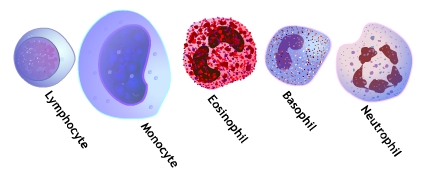How this works is based on the "Coulter principle", discovered by William Coulter in the 1940's, which says that a cell passed through an electric current in a conductive fluid such as saline will cause electrical resistance, or electronic impedance, resulting in a voltage pulse.
The number of pulses is proportional to the number of cells in the sample (which is mere microliters), and the size of the pulse is proportional to the volume of the cell.
The analyzer has two separate "baths": one for counting red blood cells (RBC's) and platelets, and another for white blood cells (WBC's). Because there is a predictable difference in the volume of these cells the instrument can differentiate between the cells based on volume. For example, particles with volumes between 2 and 20 femtoliters (10−15 liter) are counted as platelets. In addition to these counts a dilution of blood is exposed to a reagent which lyses the rbc's, causing them to rupture and spill out their contents, which includes hemoglobin.
The hemoglobin is then determined in grams per liter by passing a light through the lysed solution and reading the light transmitted at the 525nm wavelength. The amount of light absorbed at this wavelength is directly proportional to the concentration of hemoglobin. The "normal" ranges are 120 -160 g/L for non-pregnant women, and 140-180 g/L in men, though like all ranges, what the norm is may differ depending the region you live in. An example of a condition which could be discovered this way would be to find chronic anemia (low hemoglobin) with small rbc's (mean cell volume < 80 femtoliters). This is called microcytic anemia, and often indicates iron deficiency.
What is even more cool is how the analyzer then differentiates between the different types of wbc's.
It can do this through optical scatter. In the wbc bath a light is transmitted through the solution. Light will scatter in predictable ways depending on the size and complexity of the cell. As you can see from the above picture an eosinophil is larger and more internally complex than a lymphocyte; light will scatter at predictable angles based on the size of the nucleus, the number of lobes the nucleus has, and also presence of granules in the cytoplasm.
A normal white blood cell count might be something like 6 X 10^9 /L. That is 6,000,000,0000 cells per liter. During an infection this number will shoot way up, mostly due to the increase in neutrophils which are a part of the front-line defense against bacteria. Here is a video of a neutrophil attacking and phagocytosing candida yeast:
So, in under a minute our analyzers can determine the numbers and sizes of white blood cells, red blood cells, and platelets, the concentration of hemoglobin, and also differentiate white blood cells into 5 types. Word up!




No comments:
Post a Comment